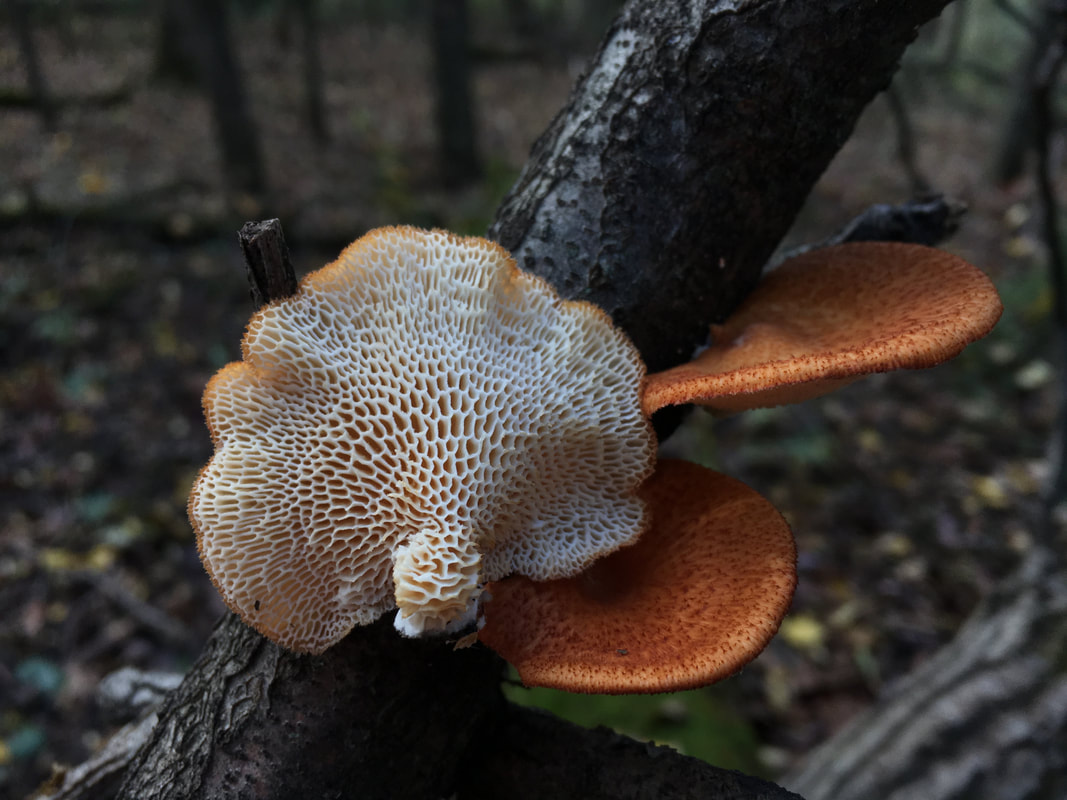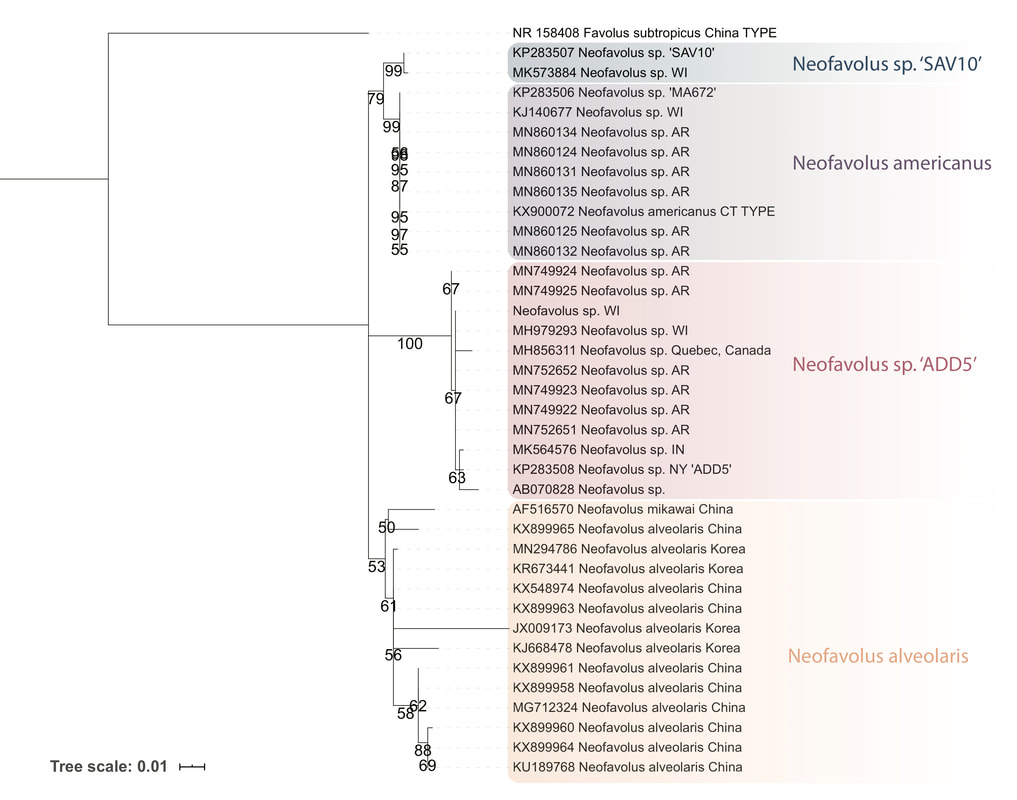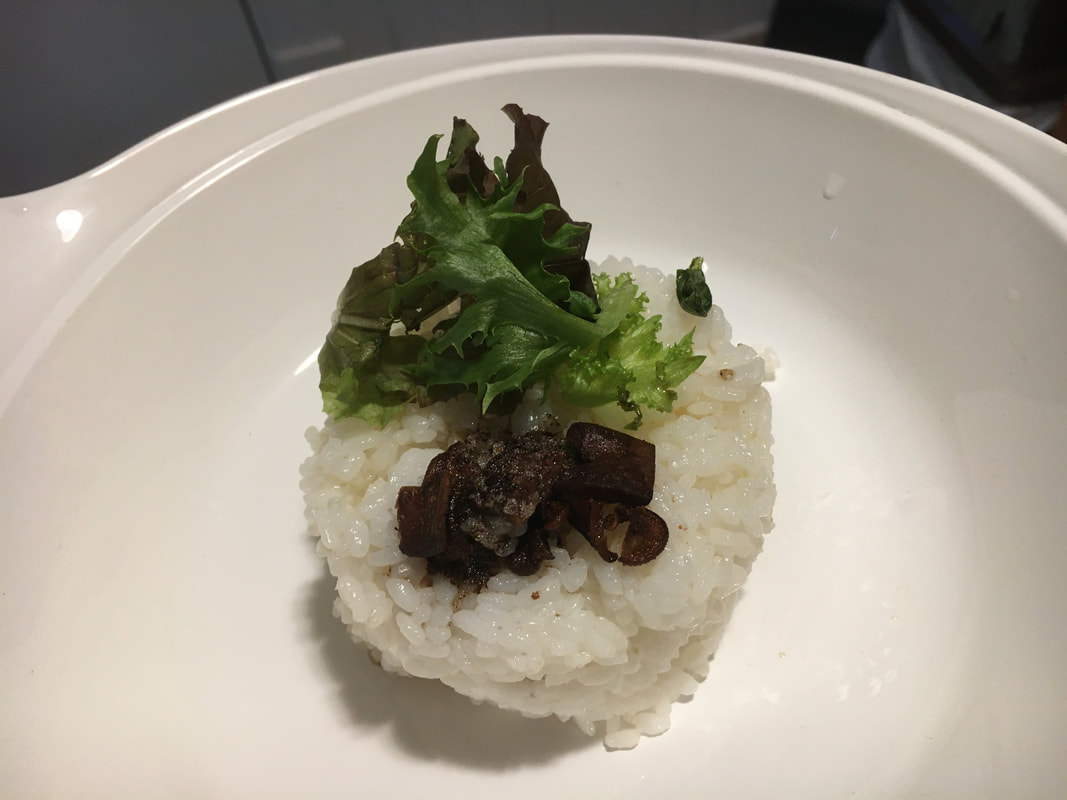|
MycoBank Taxonomy: Fungi, Dikarya, Basidiomycota, Agaricomycotina, Agaricomycetes, Polyporales, Polyporaceae, Noefavolus Mushrooms referred to as the hexagonal-pored polypore, or Neofavolus alveolaris, are common and widespread across eastern North America in the spring. They can persist through the summer, fall, and even into the winter, becoming hardened and bleached over time. Despite the common name, the pores are rarely perfectly hexagonal, instead usually vaguely and irregularly polygonal. Regardless, the hairy/scaly orange cap and large, elongated pores make this mushroom easily recognizable – that is, if we actually knew what we were identifying. Neofavolus alveolaris represents a number of cryptic species, which may not be all that suprising given that name has been applied to similar mushrooms occurring in temperate and boreal areas across the entire Northern Hemisphere (Sotome et al. 2013). In fact, it seems like Neofavolus alveolaris may not even exist in the United States (Sathiya Seelan et al. 2015). Only two or three sequences of North American mushrooms that resemble Neofavolus alveolaris have been used in phylogenetic studies but they consistently show one or more distinct North American clades represented by Neovafolus sp. 'SAV10' from Savoy Mountain, Massachusetts and Neofavolus sp. 'ADD5' from the Adirondacks, New York, perhaps among others. Recently, Xing et al. (2020) described a new species of Neofavolus from Connecticut, Neofavolus americanus. The mushrooms eaten here turned out to be 99.8% identical in terms of ITS DNA sequence to the type specimen, or the specimen that was used as the reference in creating our concept of N. americanus (when describing a new species, you can't study the morphology or sequence the DNA of all the mushrooms in the population all over the world – you have to select one or more representatives). Unable to leave this matter alone, I made a phylogeny of ITS sequences from GenBank (Figure 1). It seems like there are three sympatric clades of Neofavolus alveolaris-like mushrooms in eastern North America. Neofavolus americanus, previously described, has an ITS sequence that is 100% similar to Neofavolus sp. 'MA672'. This species has been collected from Connecticut, Massachusetts, Wisconsin, and Arkansas. Then there is the poorly sampled clade represented by Neofavolus sp. 'SAV10'. This clade shares about 98.3% similarity with Neofavolus americanus and has been collected in Massachusetts and Wisconsin. Finally, the Neofavolus sp. 'ADD5' clade has a similar broad distribution across eastern North America, having been collected in the Northeast, East, Southeast, and Midwest. This clade is only about 94-95% identical to Neofavolus americanus and Neofavolus sp. 'SAV10'. These results confirm the unique lineages of North American Neofavolus species reported by Sotome et al. (2013) and positions Neofavolus americanus relative to those lineages, which was absent from Xing et al. (2020). More research is needed to figure this situation out. For one, there appear to be no sequences of European Neofavolus alveolaris. Since the species was presumably described from France (Flore française by De Candolle in 1815), European specimens will have to anchor our species concepts. While eastern Asian specimens have been treated as Neofavolus alveolaris in phylogentic studies, it is not a given that this clade and not North American clades, or any of these clades for that matter, represent the true Neofavolus alveolaris. Furthermore, morphological analyses and mating studies will need to be carried out to determine whether Neofavolus sp. 'SAV10' and Neofavolus americanus represent distinct species. Finally, more genes need to sequenced in order to create a more robust phylogeny. Oh, you came here to learn about the edibility of the hexagonal-pored polypore? The taste was fine but even though I searched for the most tender mushrooms the texture was uneven and some overly tough bits never softened. I'm willing to give them another go next year using the somewhat-controversial-but-actually-very-reasonable boiling method described here. Other people seem to like them, like the folks at The Richest Fare. SpecimenACD0276, iNaturalist #46683944; 20 May 2020; Washtenaw Co., MI, USA; leg. Alden C. Dirks, det. Alden C. Dirks; GenBank #MZ919218 (ITS rDNA), MICH 352247. ReferencesSathiya Seelan JS, Justo A, Nagy LG, Grand EA, Redhead SA, Hibbett D. 2015. Phylogenetic relationships and morphological evolution in Lentinus, Polyporellus and Neofavolus, emphasizing southeastern Asian taxa. Mycologia 107:460–474. Sotome K, Akagi Y, Lee SS, Ishikawa NK, Hattori T. 2013. Taxonomic study of Favolus and Neofavolus gen. nov. segregated from Polyporus (Basidiomycota, Polyporales). Fungal Divers 58:245–266. Xing J-H, Zhou J-L, Cui B-K. 2020. Two new species of Neofavolus (Polyporales, Basidiomycota) based on morphological characters and molecular evidence. Mycol Prog 19:471–480. Online Resources
0 Comments
Your comment will be posted after it is approved.
Leave a Reply. |
PermalinksProject Introduction Top EdiblesHericium coralloides
Laetiporus sulphureus Morchella americana Polyporus umbellatus Suillus ampliporus Archives
April 2023
Categories |
|
|
Terms of Use, Liability Waiver, and Licensing
The material on aldendirks.com is presented for general informational and educational purposes only, and under no circumstances is to be considered a substitute for identification of an actual biological specimen by a person qualified to make that judgment. Some fungi are poisonous; please be cautious. All images on this website are licensed under Attribution-NonCommercial-NoDerivatives 4.0 International (CC BY-NC-ND 4.0). |



 RSS Feed
RSS Feed




